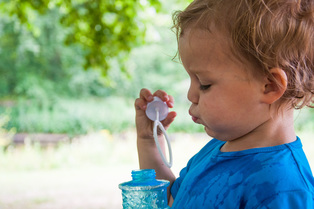 Often, yoga teachers assume that stating “find your natural breath” is a helpful tool in teaching the exercise of regulating and controlling the breath. We stop here and simply suggest connecting back with this breath once the physical practice (Asana) begins. The practice of breathing is much more meaningful then simply “focusing on the breath”. Of course this is a great place to start, but once the practice of simply observing is established we reach a new point: the practice of controlling the breath (Pranayama). In some cases, additional support is needed when teaching this idea to young ones. Pranayama is a crucial practice in yoga and we must take time to teach it in a way that introduces breath in meaningful, strategic way. Careful introduction to Pranayama can make all the difference when seeking a richer, more balanced mind and body. Below are 3 techniques that you may find helpful when teaching breath to younger children (ages 2-6), but any child or even adult can benefit from these simple techniques. 1. Tactile/Visual Support: Using something tactile is not only engaging, but helps children connect with a more rhythmic, steady breath by providing a visual representation of how the breath moves in/out and begins the awareness of the natural, fluid, movement. My favorite (and works EVERY time) is the Hoberman Ball. Kids will watch intently has the ball expands/contracts. Have a class leader to support positive participation. Other options for visual representation of the breath include bubbles, wind spinners, and feathers; think light, soft, and airy. 2. Belly Breathing Buddy: Gently place your hand or “breathing buddy” on the child’s belly. We call it “riding the breathing wave” and kids love to take a friend on a ride. Observing the rise and fall, this technique gives children a place to focus attention when directing breath into the belly. Another option if you don’t have a buddy is gently resting your hand on the child’s belly and cuing “breathe into my hand." Using your hand is effective if the child is not sensitive to touch, which is important to consider before beginning this technique. 3. Making Sounds on the Exhale: This can be as simple as “om” or something like “uuuu jjaaaii yeeee” pronouncing “Ujjayi” to extend the exhale to completion and also leaves students in a smile when finished. Bee’s Breath, also known as Bhramari, also works well. Practice together by making a humming sound like a bee, trying to direct the vibrations of the hum into the head. Couple the Bee's Breath with Pratyahara (withdrawal of senses) by covering the ears and/or closing the eyes. This places the focus inward, on the breath and minimizes external distractions. With these techniques, introducing children to breath can be both stimulating and natural. Most importantly, take time with the child. Listen to what the child needs in the moment, observe how they are naturally breathing, and invite them to explore with you by being a model of patience and consistency. by Jennie Best  Guest blogger Jennie Best teaches kids and adult classes, and is a Yoga for the Special Child practitioner with Five Keys.
0 Comments
Leave a Reply. |
Archives
July 2024
About
Just some thoughts about yoga as I go... Categories
All
|
FIVE KEYS YOGA
|
WHAT OUR CLIENTS SAYFive Keys is fantastic! The studio is lovely and soothing, and the teachers are very caring and attentive. |
I've ... probably been to 25 different yoga studios. This is one of the most welcoming, calming spaces with very talented instructors. |
I love this yoga studio. It's a great balance of a good workout and relaxation and feels like a real community. |
An ideal studio for someone new to yoga. |

 RSS Feed
RSS Feed
